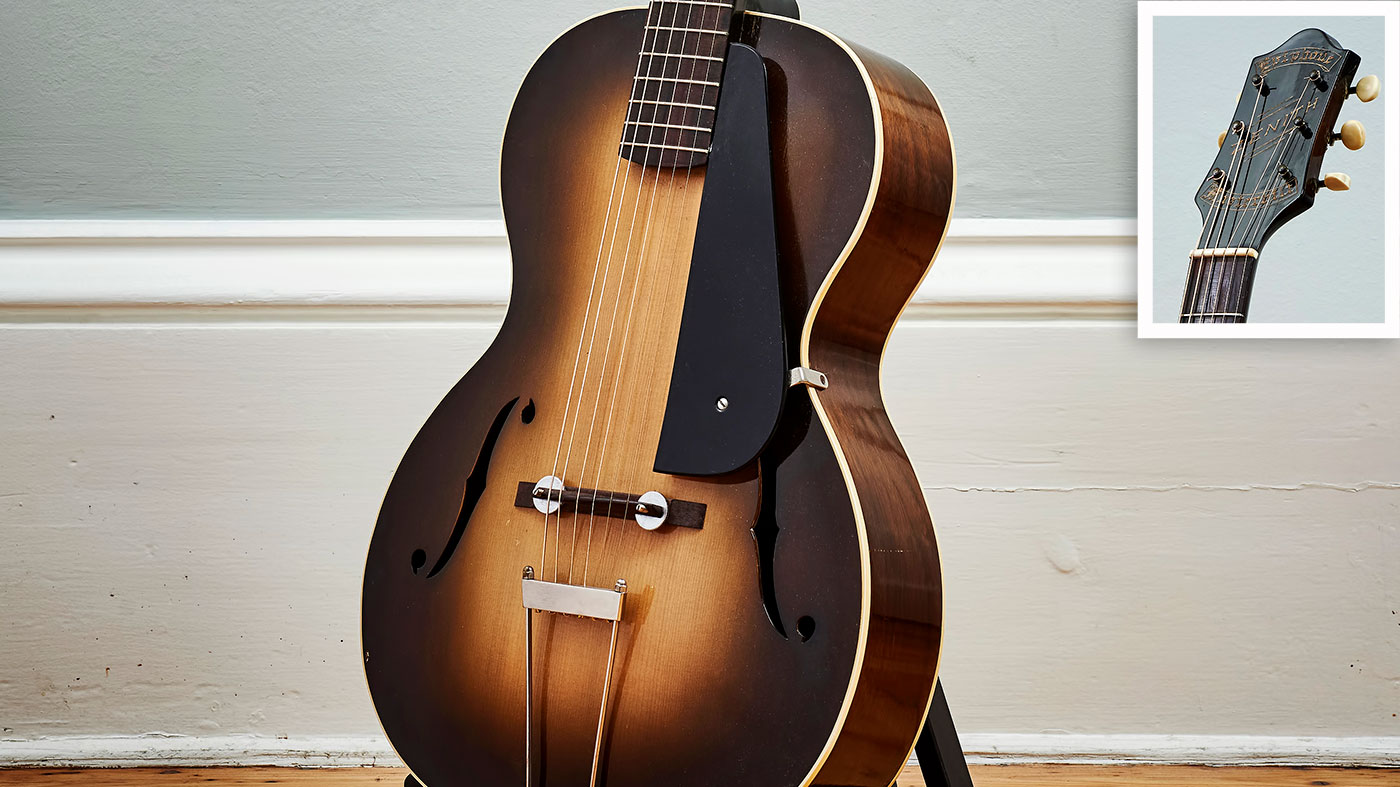Classic gear: Epiphone Zenith
Part of the Masterbilt series, the Zenith signalled a new era for Epiphone

After World War I ended just over 100 years ago on 11 November, 1918, what followed was a time of intense change as a new wave of creativity swept across the US.
The Roaring Twenties saw the emergence of jazz in America and is often regarded as the first popular youth culture movement in the country’s history. Tastes were changing en masse, and during the 1920s, a new generation of cutting-edge musicians were migrating from banjo and mandolin to guitar.
Jazz guitar was an even hotter trend by the beginning of the 1930s, but choices were still relatively limited for the jazz guitarist looking to buy a high-quality f-hole archtop. Indeed, Gibson hadn’t produced a new model since the L-5 in 1922. Although the Epiphone brand has been synonymous with Gibson since the company was acquired by CMI in 1957, they didn’t always share such a harmonious connection. They were serious market rivals during the 1930s, yet their intense competition inspired many leaps forward in development across both brands’ ranges of guitars (proving to be of tremendous benefit to guitarists!).
Despite the Great Depression, Epiphone introduced a range of guitars to the burgeoning jazzbox market in mid-1931
Ultimately, it took a suave young New York hipster by the name of Epaminondas Stathopoulo (‘Epi’ for short), aka The Duke, of the Epiphone Banjo Company to step up to the challenge and move the guitar industry forward. Despite the Great Depression, Epiphone introduced a range of guitars - with an impressive array of sizes and features - to the burgeoning jazzbox market with the release of its Masterbilt series in mid-1931. It was an insightful and well-timed move by Epi as the music scene moved into a new era. At least it appeared to jolt Gibson out of making wooden toys to try and stay afloat and into an intensely innovative period of guitar production.
At the top of the Masterbilt f-hole archtop range was the 16 3/8-inch-wide De Luxe, while the 13 5/8-inch-wide Zenith sat lower down the ranks near the humble (and now very popular) 13-inch-wide Olympic model. The Zenith originally featured a solid carved spruce top, maple back and sides and a rosewood fingerboard; however, in 1934 the width increased to 14¾ inches and the back and sides changed to walnut - a rather unusual choice of tonewood that harked back to Orville Gibson’s earliest carved top/ back guitars and mandolins.
In 1936, its width increased again to a significantly larger 16 3/8-inches. When Epiphone production relocated to Gibson’s Kalamazoo factory in the late 50s following CMI’s acquisition, the Zenith maintained this larger width for the rest of its tenure. It was eventually discontinued in 1969.
The Zenith featured is a very clean example of a model from 1933. According to a letter in its case, it has remained virtually unplayed since 1941, due to some unfortunate circumstances involving its original owner, the guitarist in Ken ‘Snakehips’ Johnson’s jazz swing band.
Want all the hottest music and gear news, reviews, deals, features and more, direct to your inbox? Sign up here.
During the Blitz, on the 8 March 1941, they were playing in London’s Café de Paris, when a bomb crashed through the building and exploded in front of the stage, obliterating the ballroom. Miraculously, at the time of the blast, the guitarist had gone outside for a cigarette and had survived. However, the shockwave burst his ear drums, so he was unable to keep playing his pride and joy that he kept at home - this Epiphone Masterbilt Zenith.
1933 Epiphone Zenith
1. Serial number
Four-digit serial number located on bottom of adjustable rosewood bridge
2. Headstock
Off-centre rounded-peak headstock shape; gothic-style ‘Epiphone Zenith Masterbilt’ engraved gold logos on black plastic headstock veneer

3. Body
13 5/8 inches wide; maple back and sides; carved spruce top; Sunburst finish; three-segment f-holes (x2)
4. Hardware
Three-on-a-plate tuners; trapeze tailpiece; adjustable rosewood bridge

5. Plastics
White Pyralin single top and back body binding; white Pyralin heel cap; raised black Bakelite pickguard; white plastic tuner buttons; black plastic headstock veneer
6. Neck
Reinforced, non-adjustable two-piece mahogany neck with maple centre-ply; rounded profile (similar to modern ‘C’); 1 11/16-inch nut width; 20-fret rosewood fingerboard with dot inlays

The evolution of the Epiphone Zenith
- 1931 Zenith released as part of Masterbilt range; 135/8 inches wide; maple back & sides
- 1933 Single bound top & back; black Bakelite pickguard; diagonal ‘Zenith’ engraved headstock
- 1934 14¾ inches wide; walnut back & sides; block-letter logo; 3-on-a-plate tuners
- 1936 163/8 inches wide; script logo; individual tuners
- 1939 Centre-dip headstock shape replaces rounded-peak type
- 1949 Maple back and sides, and blonde finish now available
- 1958 Production commences at Gibson’s Kalamazoo factory; 163/8 inches wide
- 1965 Available only as a special factory order
- 1969 Discontinued
Rod Brakes is a music journalist with an expertise in guitars. Having spent many years at the coalface as a guitar dealer and tech, Rod's more recent work as a writer covering artists, industry pros and gear includes contributions for leading publications and websites such as Guitarist, Total Guitar, Guitar World, Guitar Player and MusicRadar in addition to specialist music books, blogs and social media. He is also a lifelong musician.


